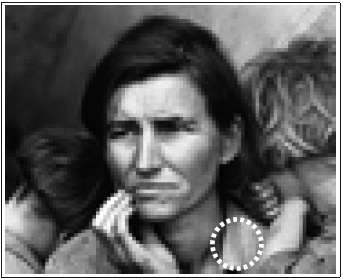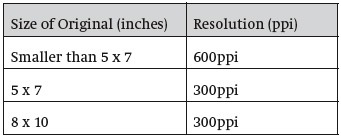Image Resolution for Continuous-Tone Scans
Resolution is a major factor in determining the quality of all scans. Resolution is the number of pixels per unit of measure (inches, in the United States, hence the abbreviation ppi) used to form an image. In general, photographic scans intended for print usage should be at least 300ppi at the final size for reproduction. Resolution should be determined at the scanning stage based on the qualities of the originating image: (1) whether it is continuous-tone or bi-tonal and (2) the size of the original. For further guidance, see the table below.

Fig. 2.1 – 300ppi
Example of a properly scanned, grayscale photograph at 300ppi. This resolution setting is suitable for high-quality offset print production.

Fig. 2.2 – 72ppi (Note the pixelized edges and loss of details.)
Example of a photograph scanned at 72ppi, resulting in an image that appears blurry or out of focus. Pixelation is another phenomenon associated with a low-resolution scan. Low-resolution settings are not suitable for print.

Fig. 2.3 – Scanned at 72ppi; with resolution artificially increased to 300ppi (Compare the circled areas in the figures.)
Example of a low-resolution scan to which resolution has been artificially added. Note that there is little improvement in detail in fig. 2.3 after resolution has been added.
Determining Resolution Settings for Continuous-tone Resolution Scans

Save all scans in the TIFF or EPS format.
Continuous-tone or Bi-tonal?
To determine whether you should scan your original art in continuous-tone mode (8-bit) or in bi-tonal mode (1-bit), consider the following:
– If your original is a photograph or fine-art drawing that contains multiple levels of gray tones, you should scan the original in continuous-tone mode.
– If the original is a line drawing without any gray tonalities and consists only of black-and-white lines and shapes, you should scan it in bi-tonal mode.
Terminology:
Pixelation: A phenomenon in bitmap images that results from insufficient resolution or over-enlargement. Individual pixels become visible, especially on the edges of objects, creating a stair-stepped or jagged look.



 Spring/Summer 2026
Spring/Summer 2026